Vietnam’s Pu Luong Nature Reserve stands as a serene counterpoint to the country’s bustling cities and popular coastal destinations. This hidden gem in the northern province of Thanh Hoa offers travelers an authentic glimpse into rural Vietnam, where emerald rice terraces cascade down limestone mountains and traditional wooden stilt houses dot the landscape. Away from the well-trodden tourist path, Pu Luong provides a rare opportunity to experience unspoiled nature alongside the daily rhythms of ethnic Thai and Muong communities. Whether you’re seeking adventure through jungle treks or tranquility among traditional villages, Pu Luong delivers a genuine Vietnamese experience that feels increasingly rare in our hyperconnected world.
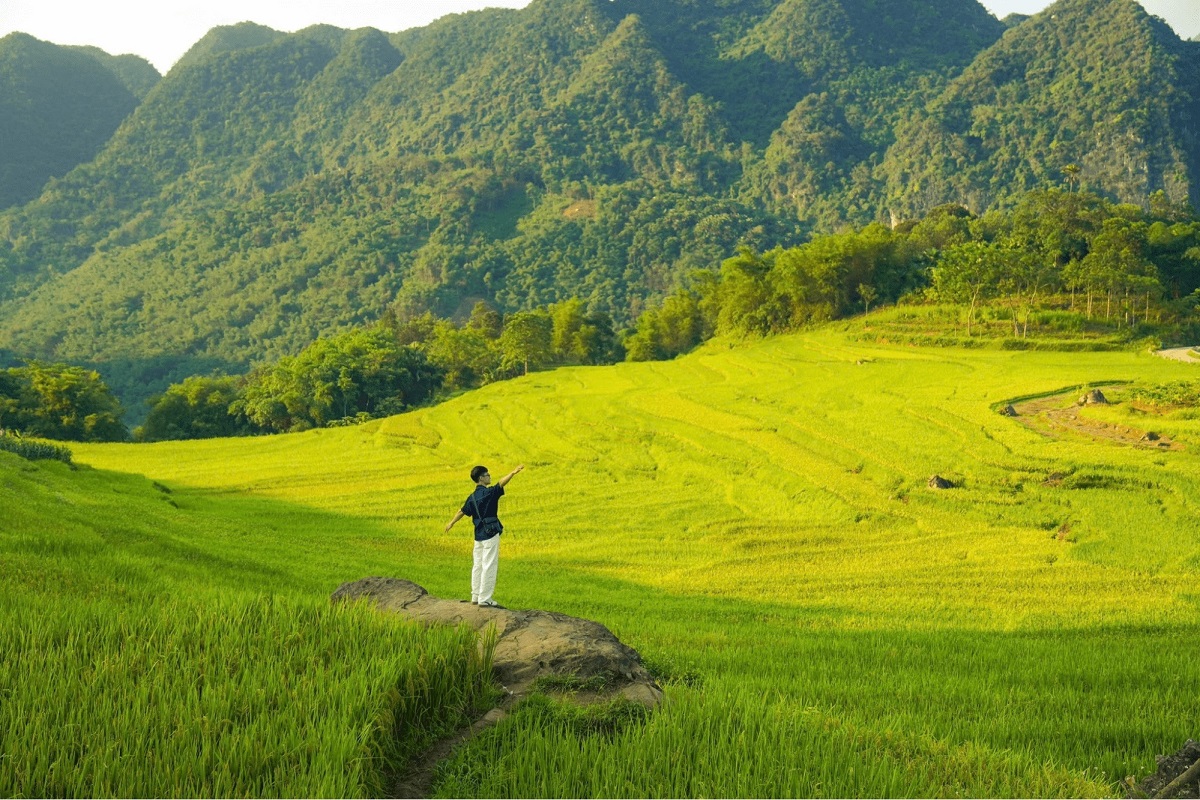
1. Why Visit Pu Luong?
Pu Luong Nature Reserve, established in 1999, covers approximately 17,600 hectares of lush forest and agricultural land in northern Vietnam. This protected area lies about 160 kilometers southwest of Hanoi, making it accessible yet remarkably preserved from mass tourism. The reserve spans two districts Ba Thuoc and Quan Hoa and is characterized by its dramatic karst landscape, dense forests, and vibrant cultural heritage.
What truly sets Pu Luong apart is its perfect balance of natural splendor and cultural authenticity. Unlike more developed tourist destinations, this reserve maintains its genuine character with limited commercial infrastructure. Visitors can witness traditional farming techniques that have remained largely unchanged for centuries, including the iconic water wheels that channel mountain streams into terraced rice fields.
The biodiversity of Pu Luong offers another compelling reason to visit. The reserve is home to over 1,000 plant species, 84 mammal species, and nearly 300 bird species, some of which are rare and endangered. Hiking through Pu Luong’s forests might reward you with glimpses of flying squirrels, leopard cats, or even the elusive clouded leopard if you’re exceptionally fortunate. This ecological richness, combined with breathtaking landscapes and authentic cultural experiences, makes Pu Luong an ideal destination for travelers seeking to connect with Vietnam beyond its tourist hotspots.
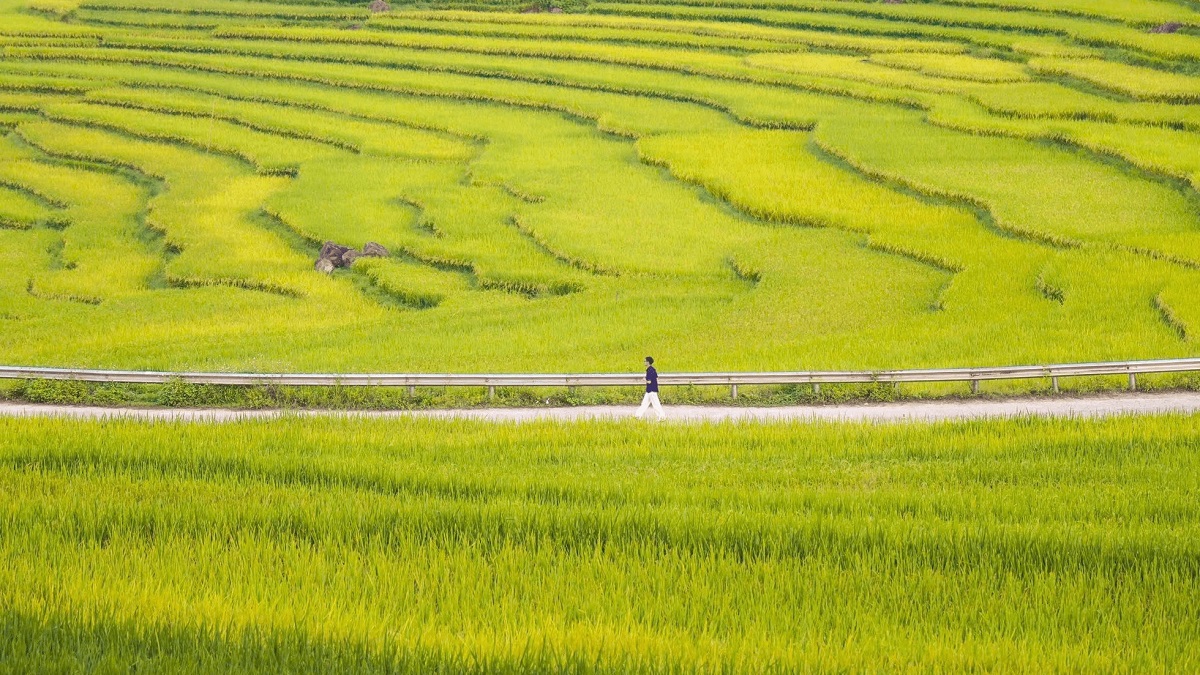
Best places to visit in Northern Vietnam a complete 2025 guide
2. When to Go: Weather, Seasons & Festivals
The best time to visit Pu Luong largely depends on what you hope to experience during your stay. The reserve experiences distinct seasonal changes that dramatically transform its landscapes and activities throughout the year. Understanding these patterns will help you plan the perfect trip aligned with your preferences.
2.1 Dry Season (November to April)
November through April marks the dry season in Pu Luong, characterized by pleasant temperatures and minimal rainfall. This period is ideal for trekking and outdoor activities as trails remain accessible and relatively mud-free. December and January bring cooler temperatures, especially in the evenings, with daytime averages of 15-20°C (59-68°F). The winter months offer crystal-clear skies and spectacular visibility across the valleys, perfect for photography enthusiasts. If you visit during February, you might witness local New Year celebrations as ethnic communities welcome spring with traditional dances, music, and feasting.
2.2 Rice Growing Seasons
May-June and September-October represent the most visually stunning periods to visit Pu Luong. In May and June, newly planted rice shoots transform the terraced fields into vibrant emerald carpets. The beginning of the rainy season brings lush vegetation and flowing waterfalls, though occasional afternoon showers should be expected. September and October showcase the golden harvest season when the rice terraces turn a magnificent yellow-gold. During harvest time, you’ll witness farmers working in the fields using traditional methods, creating photogenic scenes that capture rural Vietnamese life. The “Com Moi” festival in October celebrates the new rice with feasting and traditional performances, offering a unique cultural immersion.
2.3 Rainy Season (May to October)
While the rainy season brings occasional challenges, it also offers unique advantages. The landscape becomes incredibly lush, waterfalls reach their full majesty, and fewer tourists mean more authentic experiences. July and August represent the peak of the rainy season with the heaviest precipitation. These months bring dramatic afternoon thunderstorms, creating misty mornings and vibrant rainbows. Though some trails become muddy and challenging, the photographic opportunities are unmatched as clouds drift through valleys and water-filled rice terraces reflect the sky. Phieu Travel guides are well-versed in navigating this season, ensuring safe and memorable experiences even during the rainier months.
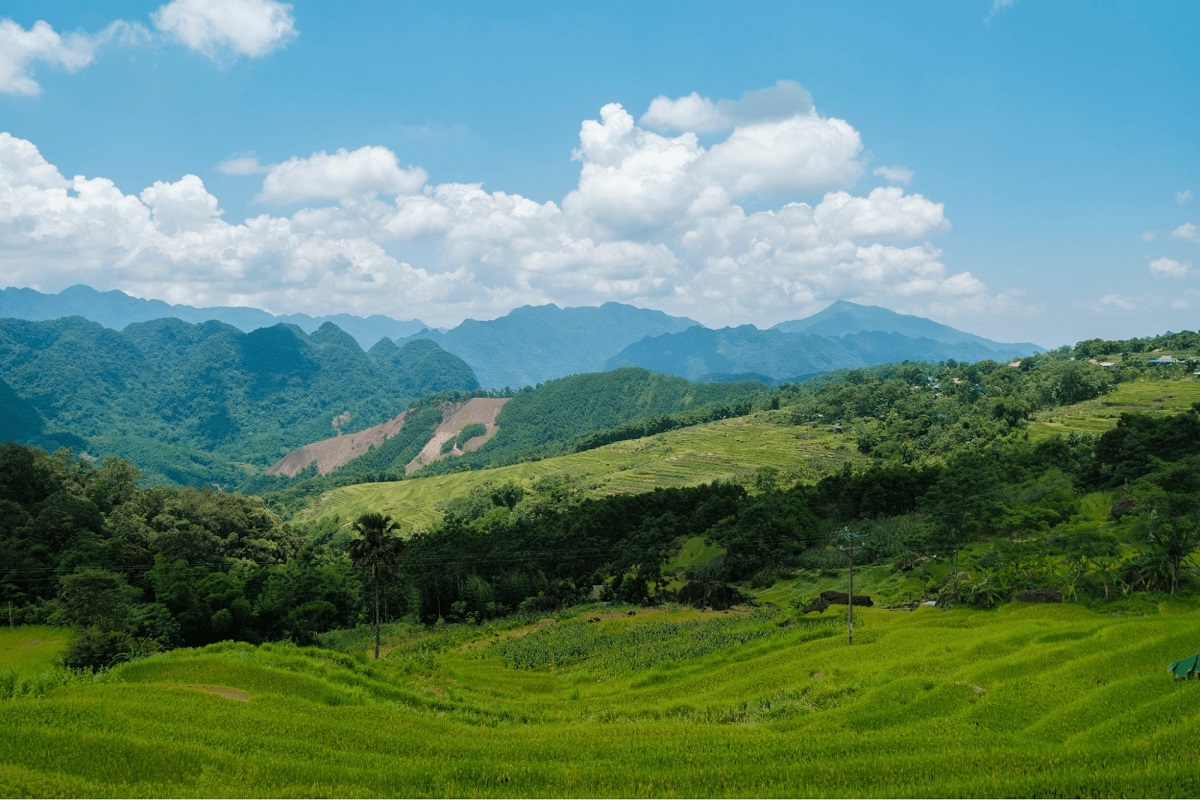
Top 4 rice fields Vietnam destinations & perfect times to go
3. How to Get to Pu Luong + Map
Reaching Pu Luong requires some planning, but the journey itself becomes part of the adventure as you transition from urban Vietnam to its rural heartland. Several transportation options exist, each offering different levels of convenience, cost, and flexibility.
3.1 From Hanoi by Bus
The most economical option involves taking a public bus from Hanoi to Canh Nang town, the gateway to Pu Luong. Buses depart from My Dinh or Giap Bat bus stations several times daily, with the journey taking approximately 4-5 hours. Ticket prices range from 150,000-200,000 VND ($6-8 USD). From Canh Nang, you’ll need to arrange local transport to your specific destination within the reserve, typically via motorbike taxi or pre-arranged pickup. While budget-friendly, this option requires some flexibility and basic Vietnamese language skills to navigate connections smoothly.
3.2 Private Car or Taxi
For maximum convenience, private car services from Hanoi offer door-to-door transportation. This option costs between 1,500,000-2,500,000 VND ($60-100 USD) depending on vehicle type and allows you to stop at viewpoints along the way. The journey takes about 4 hours, with the route passing through scenic countryside and small towns. Phieu Travel can arrange reliable drivers who know the best routes and scenic stops, making this option particularly appealing for families or groups of 3-4 travelers sharing costs.
3.3 Combined with Mai Chau
Many visitors combine Pu Luong with nearby Mai Chau Valley. If following this route, take a bus or taxi to Mai Chau first, spend a night or two there, then continue to Pu Luong via local transport. This scenic route crosses the impressive Thung Khe Pass, offering breathtaking mountain views before descending into Pu Luong’s valleys. The journey from Mai Chau to Pu Luong takes approximately 1.5-2 hours by car or motorbike and allows you to experience two distinct cultural regions of northern Vietnam.
3.4 Navigating Within Pu Luong
Once in Pu Luong, transportation between villages typically involves walking, motorbike taxis, or pre-arranged jeeps for more remote areas. Many homestays can arrange local transport for day trips or transfers. The reserve’s main road connects most major villages, though some trekking routes require guides familiar with mountain paths. Mobile phone coverage exists in most villages, allowing you to contact homestays for pickup arrangements if needed. Phieu Travel coordinates these logistics seamlessly, ensuring smooth transitions between experiences throughout your stay.
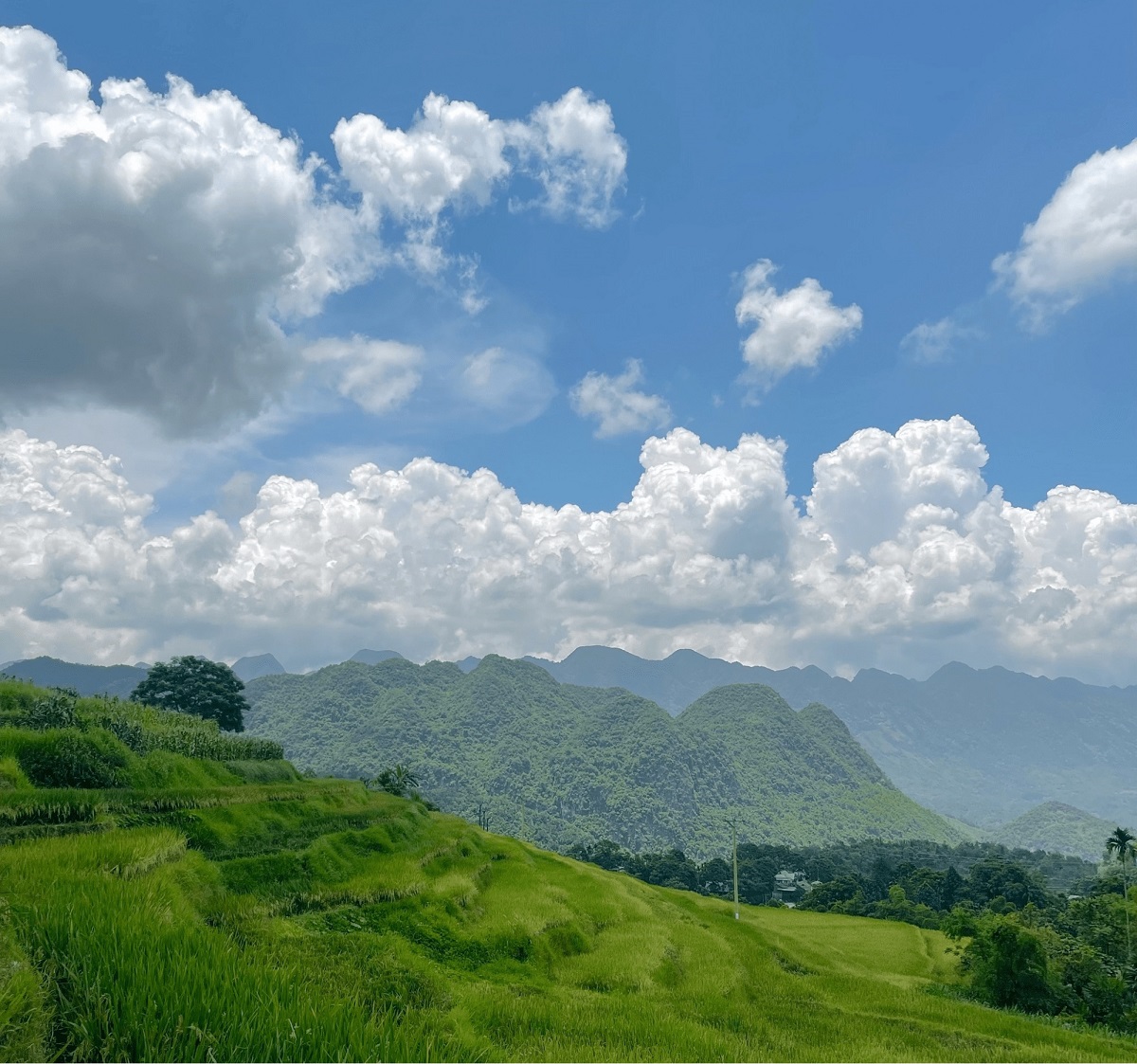
4. Where to Stay in Pu Luong
Accommodation in Pu Luong primarily revolves around authentic homestays and eco-lodges, offering immersive experiences rather than conventional hotel luxury. Each option provides unique insights into local life while supporting community-based tourism initiatives.
4.1 Traditional Homestays
Homestays represent the most authentic accommodation option in Pu Luong, allowing guests to live alongside local families in traditional stilt houses. These wooden structures, elevated on stilts with thatched or tile roofs, typically offer simple mattresses on bamboo floors with mosquito nets, communal bathrooms, and family-style dining. Popular homestay villages include Ban Hieu, Kho Muong, and Ban Don, each offering slightly different landscapes and cultural experiences. Prices range from 250,000-400,000 VND ($10-17 USD) per person including meals, making them both affordable and culturally enriching. Many homestay hosts speak limited English but communicate warmly through gestures and shared activities like cooking or farming.
4.2 Eco-Lodges and Retreats
For those seeking more comfort while maintaining an authentic experience, several eco-lodges blend local architecture with modern amenities. Pu Luong Retreat and Pu Luong Treehouse stand out as premier options, offering private bungalows with en-suite bathrooms, comfortable beds, and spectacular views of terraced rice fields. These properties feature infinity pools overlooking the valleys, restaurant facilities serving both Western and Vietnamese cuisine, and organized activities like guided hikes and cultural demonstrations. Prices range from $60-120 USD per night depending on the season and room type. These lodges employ local staff and maintain sustainable practices while providing a comfortable base for exploring the reserve.
4.3 Booking Tips and Recommendations
Reservations become essential during peak seasons (September-October and February-April), particularly for the limited eco-lodges. Many smaller homestays don’t maintain online booking systems, making advance arrangements through local operators like Phieu Travel valuable. Consider splitting your stay between different villages to experience various landscapes and communities within Pu Luong. Ban Hieu offers spectacular panoramic views from its hillside location but requires a moderate hike to reach. Kho Muong provides easier access while nestled beside limestone cliffs and caves. Ban Don sits closer to the main road, making it ideal for shorter stays or those with limited mobility.
The authentic accommodations in Pu Luong require some flexibility regarding amenities and comfort levels. Most locations have electricity but may experience occasional outages. Wifi exists at eco-lodges and some homestays but can be unreliable. These minor inconveniences are more than compensated by the warm hospitality, cultural immersion, and spectacular settings that make staying in Pu Luong a highlight of any Vietnam journey.
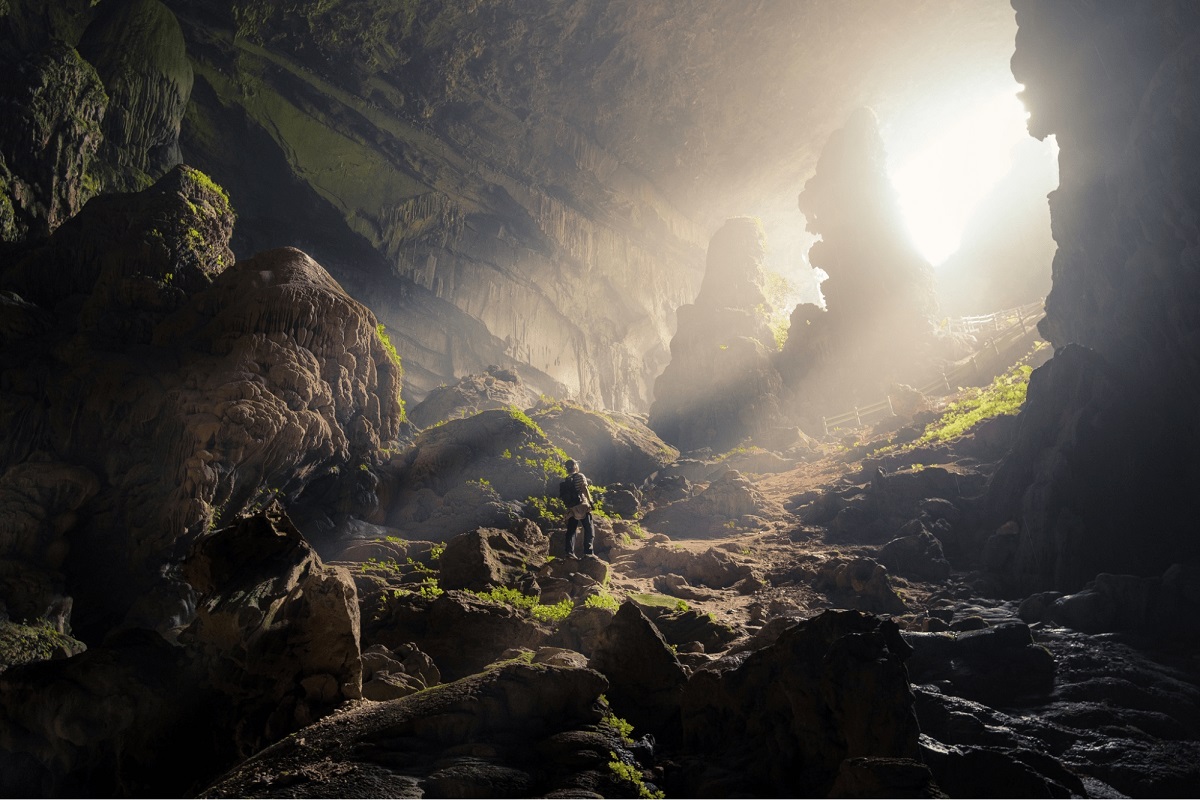
5. Top Things to Do in Pu Luong
Pu Luong offers diverse activities that connect visitors with both nature and culture. From challenging hikes to cultural immersion, the reserve provides authentic experiences that showcase rural Vietnamese life and stunning landscapes.
The activities here revolve around natural beauty and cultural heritage rather than manufactured attractions. Trekking through terraced rice fields and forests forms the backbone of most itineraries, allowing travelers to witness traditional farming techniques and daily village life. Water activities like bamboo rafting provide refreshing alternatives during warmer months. Cultural experiences such as traditional dance performances and cooking classes offer deeper connections with the Thai and Muong communities who have inhabited these valleys for generations.
Many visitors find that slowing down and simply observing daily life becomes a highlight of their stay. Watching farmers guide water buffalo through terraced fields, women weaving textiles on front porches, or children playing traditional games offers authentic glimpses into rural Vietnamese life that feel increasingly rare in our modern world.
5.1 Best Trekking Routes & Viewpoints
Trekking represents the primary activity in Pu Luong, with routes ranging from easy village walks to challenging mountain hikes. The Ban Hieu trek stands as one of the most popular routes, following ancient paths between villages while offering spectacular valley views. This moderate 6-8 kilometer hike traverses terraced fields and bamboo forests, requiring approximately 3-4 hours to complete. For more adventurous travelers, the Pu Luong to Cham trek presents a challenging full-day hike across varied terrain with sections of steep ascent and descent.
Several spectacular viewpoints reward those willing to make the climb. Pu Luong Retreat Viewpoint offers accessible panoramas just a short walk from the main road. For more dramatic vistas, the hike to Ban Hieu village culminates at a ridge with 360-degree views across terraced fields and limestone formations. The Pha Dau viewpoint near Don village provides sunset views that photographers particularly cherish. Phieu Travel guides know the perfect timing for each viewpoint, ensuring you experience these landscapes in their best light while avoiding crowds.
Local guides enhance these treks with cultural context and safety expertise. They identify edible forest plants, explain traditional farming techniques, and navigate seasonal trail conditions that can change dramatically between dry and rainy seasons. Most importantly, they facilitate meaningful interactions with villagers encountered along the way, transforming a simple hike into a cultural journey.
5.2 Exploring Ethnic Minority Villages
The ethnic Thai and Muong communities of Pu Luong maintain cultural traditions that have largely disappeared elsewhere in Vietnam. Ban Hieu village, perched on a hillside with panoramic views, offers insights into traditional stilt house architecture and agricultural practices. Kho Muong village nestles against limestone cliffs and features a fascinating agricultural system integrating terraced fields with natural springs. Ban Don village provides easier access while maintaining authentic cultural experiences, making it ideal for visitors with limited mobility.
Respectful village visits offer opportunities to observe traditional crafts like bamboo weaving, textile production, and agricultural techniques. Many homestays arrange cultural performances featuring traditional Thai dances and musical instruments, particularly for groups. Cooking classes with local families provide hands-on experience preparing regional specialties using ingredients often harvested directly from nearby gardens and forests. These activities support cultural preservation while creating meaningful connections between visitors and community members.
Etiquette remains important during village visits. Ask permission before photographing people, dress modestly (covering shoulders and knees), and remove shoes before entering homes. Small gifts like tea or fruit for host families are appreciated but not expected. Taking time to learn a few basic Thai or Vietnamese phrases demonstrates respect and typically results in warmer welcomes and more authentic interactions.
5.3 Unique Activities: Water Wheels, Bamboo Rafting, Markets
Traditional water wheels represent engineering marvels that have irrigated Pu Luong’s terraced fields for centuries. These bamboo structures harness flowing streams to lift water to higher elevations without electricity or modern pumps. The best examples can be found near Ban Hieu and Kho Muong villages, where they continue functioning as essential agricultural tools rather than tourist attractions. Early mornings offer the best opportunities to observe farmers maintaining these systems, adjusting the wheels to accommodate changing water levels.
Bamboo rafting provides a refreshing activity during warmer months. Local guides navigate traditional bamboo rafts along gentle river sections, providing unique perspectives of the landscape from water level. These excursions typically last 1-2 hours and often include stops at riverside villages or swimming opportunities in clean, clear pools. The activity offers welcome cooling during hot days while demonstrating traditional transportation methods still used by some villagers.
Local markets rotate between villages on different days, with the most accessible at Canh Nang town every five days according to the lunar calendar. These authentic rural markets primarily serve local communities rather than tourists, offering fascinating glimpses into regional commerce and social life. Colorful textiles, agricultural tools, medicinal herbs, and seasonal produce fill bamboo stalls while villagers from surrounding areas gather to trade goods and news. Phieu Travel can align your itinerary with market days, creating opportunities to experience these vibrant community gatherings.
5.4 Best Waterfalls & Caves
Hieng Waterfall stands as Pu Luong’s most impressive cascade, particularly during and shortly after rainy season. The multi-tiered falls drop approximately 50 meters through lush forest, creating natural swimming pools at various levels. Reaching the falls requires a moderate 3-kilometer hike from the nearest road, typically taking 45-60 minutes each way. The trail passes through forests and small fields, with sections that become slippery after rain. Early morning visits avoid both heat and potential afternoon crowds during peak season.
Doi Cave near Kho Muong village represents one of the reserve’s most fascinating geological features. This massive limestone cave features impressive stalactite and stalagmite formations throughout its accessible chambers. Local guides lead explorations with handheld lamps, explaining both the geological significance and cultural importance of the cave in Thai mythology. The cave maintains cool temperatures year-round, offering welcome relief during hotter months. Appropriate footwear is essential as some sections involve uneven surfaces and occasionally slippery conditions.
Lesser-known but equally fascinating, Bat Cave houses thousands of insect-eating bats in its upper chambers. Evening visits allow observation of mass bat emergences as they leave to feed, creating spectacular natural displays. Various smaller caves dot the limestone landscape throughout Pu Luong, many holding cultural significance for local communities as historical shelters or spiritual sites. Guided exploration ensures both safety and respectful engagement with these natural and cultural treasures.
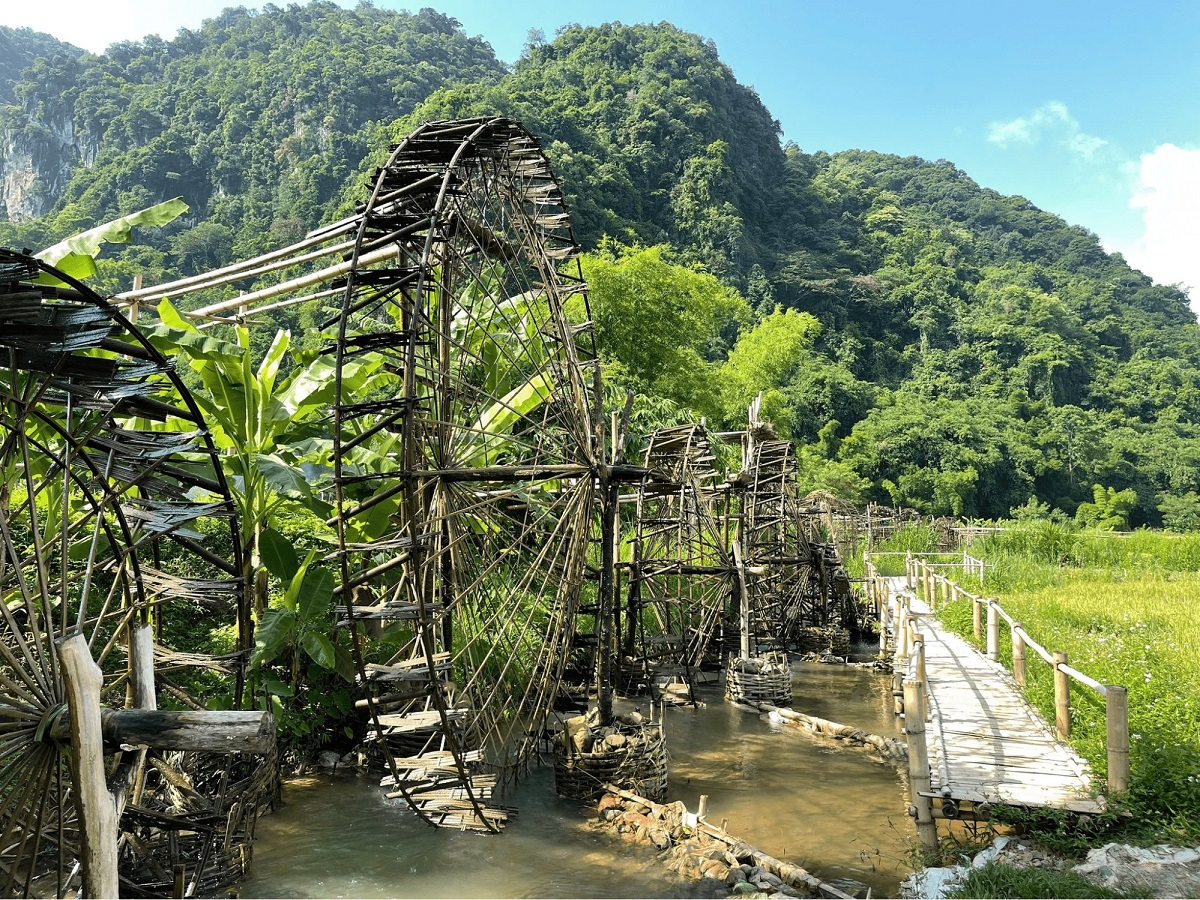
6. Essential Tips for Visiting Pu Luong
Proper preparation enhances both enjoyment and respect for local communities when visiting Pu Luong. These practical tips address common concerns while promoting responsible tourism practices.
6.1 Packing Essentials
- Lightweight, moisture-wicking clothing that dries quickly.
- Long-sleeved shirts and pants (for sun/insect protection and cultural respect).
- Sturdy walking shoes or hiking boots with good traction.
- Rain jacket or poncho (essential year-round).
- Small backpack for day hikes.
- Insect repellent and sunscreen.
- Basic first aid supplies.
- Headlamp or flashlight (for evenings and cave visits).
- Reusable water bottle.
- Cash in small denominations (ATMs unavailable within the reserve).
6.2 Practical Considerations
Pu Luong remains relatively undeveloped, requiring flexibility regarding conveniences. Mobile phone coverage exists in most villages but can be spotty in valleys and remote areas. Most accommodations offer wifi, though connections may be slow or intermittent. Banking facilities don’t exist within the reserve, making it essential to bring sufficient cash from Hanoi or nearby towns. Medical facilities are limited to basic clinics in larger towns, with serious issues requiring evacuation to Hanoi.
Language presents another consideration, as English proficiency varies widely. Homestay hosts often speak limited English, while eco-lodge staff typically have better language skills. Learning a few basic Vietnamese phrases demonstrates respect and facilitates warmer interactions. Phieu Travel guides bridge these language gaps, ensuring clear communication throughout your stay while allowing authentic cultural exchanges.
6.3 What to Eat in Pu Luong
Culinary experiences in Pu Luong revolve around fresh, locally-sourced ingredients prepared according to traditional recipes. Meals at homestays typically feature family-style dining with multiple shared dishes. Rice forms the foundation of most meals, often grown in the very fields visible from your accommodation. Sticky rice, steamed in bamboo tubes or banana leaves, accompanies many meals as a regional specialty.
Protein sources include free-range chicken, pork, and occasionally buffalo meat, typically prepared in stir-fries or slow-cooked stews flavored with forest herbs. Freshwater fish from local streams appears regularly, often grilled or steamed with aromatics. Vegetable dishes feature whatever is in season, from tender bamboo shoots to foraged ferns and cultivated greens. Many homestays maintain gardens where you can observe ingredients growing before they reach your plate.
Local specialties worth trying include “com lam” (bamboo-tube rice), “thang co” (herb-infused meat stew), and various dishes incorporating forest mushrooms available during rainy season. Rice wine, produced locally and often flavored with fruits or herbs, accompanies special meals and celebrations. While accommodations can usually address dietary restrictions with advance notice, options may be somewhat limited in more remote homestays.
6.4 Responsible & Sustainable Travel Advice
Responsible tourism practices help preserve both Pu Luong’s natural environment and cultural heritage. Pack out all trash, particularly non-biodegradable items like plastic wrappers or bottles. Many villages lack comprehensive waste management systems, making visitor responsibility especially important. Consider bringing a reusable straw, utensils, and shopping bag to minimize plastic waste.
Water conservation matters despite the region’s apparent abundance. Brief showers and reusing towels reduce impact on local water systems. Choose locally-made souvenirs that support traditional crafts rather than imported items. Textiles, bamboo products, and agricultural specialties like honey or tea make meaningful purchases that directly benefit community members.
Respect for local customs enhances cultural preservation. Ask permission before photographing people, religious sites, or private homes. Dress modestly, particularly when visiting villages or participating in community activities. Remove shoes when entering homes, and follow cues from local residents regarding appropriate behavior during ceremonies or gatherings.
Phieu Travel incorporates these responsible practices into all Pu Luong itineraries, partnering with community-based tourism initiatives that ensure tourism benefits flow directly to local residents. By choosing operators with strong ethical commitments, visitors contribute to both environmental conservation and cultural sustainability in this special region.
Pu Luong Nature Reserve represents Vietnam at its most authentic a place where traditional agricultural practices continue alongside modern life, where forests shelter rare biodiversity, and where visitors can experience genuine cultural exchanges. The dramatic landscapes of terraced rice fields cascading down limestone mountains create unforgettable scenery that changes with each season. Meanwhile, encounters with Thai and Muong communities offer insights into ways of life that have remained resilient despite rapid changes elsewhere in Vietnam.
Unlike more developed tourist destinations, Pu Luong rewards travelers willing to embrace a slower pace and occasional rustic conditions with deeply authentic experiences. The absence of mass tourism infrastructure becomes a genuine advantage, allowing more meaningful connections with both nature and local communities. Whether trekking through emerald rice terraces, learning traditional cooking techniques from homestay hosts, or simply watching sunset paint limestone cliffs in golden light, Pu Luong offers moments of connection increasingly rare in our hyperconnected world.
As Vietnam continues developing its tourism industry, places like Pu Luong become increasingly precious windows into traditional lifeways and natural environments that deserve both appreciation and protection. By visiting responsibly, travelers contribute to sustainable development that values cultural heritage and environmental conservation alongside economic opportunity. Phieu Travel remains committed to facilitating these experiences through carefully designed itineraries that benefit local communities while providing memorable adventures for visitors. Discover more about experiencing authentic Pu Luong and other hidden Vietnamese destinations at Phieutravel.com, where responsible tourism meets unforgettable experiences in Vietnam’s most spectacular landscapes.
Read more:
- Best time to visit Vietnam ultimate guide by region, month & travel type
- Things to buy in Vietnam the complete traveler’s shopping guide
- Driving License Requirements for Vietnam Motorbike Loop (2025 Guide)

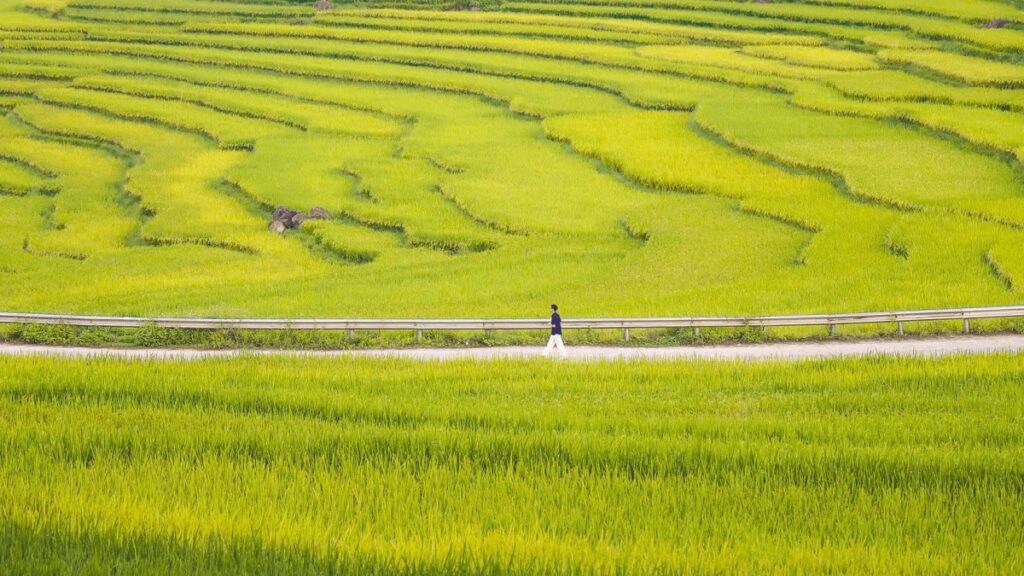
You Might Also Like
Ha Giang Weather in September: Complete Guide for Travelers
Exploring the magnificent Ha Giang Loop in September offers travelers a perfect balance of favorable[...]
Quan Ba Twin Mountains: Ha Giang’s Iconic Fairy Hills and Complete Travel Guide
The mystical Quan Ba Twin Mountains rise from the emerald valleys of Ha Giang like[...]
Vuong family mansion: the architectural marvel and cultural legacy of Ha Giang
Deep in Vietnam’s northern highlands, where mist-shrouded mountains meet terraced rice fields, stands a testament[...]
Ha Giang Loop Safety Tips: How to Ride Securely in Vietnam’s Northern Mountains
The Ha Giang Loop, with its winding mountain roads and breathtaking landscapes, offers one of[...]
The Ultimate Guide to the M-Shaped Curve on Ha Giang Loop
Vietnam’s remote northern province of Ha Giang hides a natural wonder that has captivated adventurous[...]
Most Beautiful Places to Visit in Vietnam: Essential Destinations and Insider Tips
Vietnam captivates travelers with its stunning landscapes, rich cultural heritage, and warm hospitality. From mist-shrouded[...]
Beyond the Beaten Path: Discovering Ha Giang Province in Northeast Vietnam
Ha Giang Province in Northeast Vietnam stands as one of the country’s last frontiers for[...]
Rainy season in Ha Giang: what to expect, when to go, and travel tips
Vietnam’s northern frontier reveals a different face during the rainy season, transforming Ha Giang’s limestone[...]